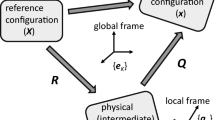Summary
G-structures are the geometric backbone of the theory of material uniformity in continuum mechanics. Within this geometric framework, anelasticity is seen as a result of evolving distributions of inhomogeneity reflected as material nonintegrability. Constitutive principles governing thetime evolution of the G-structure underlying the finite-strain theory of anelasticity (e.g., plasticity) are proposed. The material Eshelby stress tensor is shown to be thedriving force behind this evolution. This should allow for a thermodynamically admissible formulation of anelasticity viewed as a G-structure evolution.
Similar content being viewed by others
References
Epstein, M., Maugin, G. A.: The energy-momentum tensor and material uniformity in finite elasticity. Acta Mech.83, 127–133 (1990).
Noll, W.: Materially uniform simple bodies with inhomogeneities. Arch. Rat. Mech. Anal.27, 1–32 (1967).
Wang, C.C.: On the geometric structure of simple bodies, a mathematical foundation for the theory of continuous distributions of dislocations. Arch. Rat. Mech. Anal.27, 33–94 (1967).
Bloom, F.: Modern differential geometric techniques in the theory of continuous distributions of dislocations. Lecture Notes in Mathematics, No. 733. Berlin Heidelberg New York: Springer 1979.
Cohen, H., Epstein, M.: Remarks on uniformity in hyperelastic materials. Int. J. Solids Struct.20, 233–243 (1984).
Elzanowski, M., Epstein, M., Sniatycki, J.:G-structures and material inhomogeneity. J. Elasticity23, 167–180 (1990).
Maugin, G.A.: Eshelby stress in elastoplasticity and ductile fracture. Int. J. Plasticity10, 393–408 (1994).
Epstein, M.: Eshelby-like tensors in thermoelasticity. In: Nonlinear thermomechanical processes in continua (Muschik, W., Maugin, G.A., eds.)61, pp. 147–159. Berlin: TUB-Dokumentation 1992.
Epstein, M., Maugin, G.A.: Thermoelastic material forces: definition and geometric aspects (submitted for publication, 1994).
Lee, E.H.: Elastic plastic deformation at finite strain. A.S.M.E.Trans. J. Appl. Mech.36, 1–6 (1969).
Mandel, J.: Equations constitutives et directeurs dans les milieux plastiques et viscoplastiques. Int. J. Solids Struct.9, 725–740 (1972).
Lubliner, J.: Plasticity theory. New York: McMillan 1990.
Cleja-Tigoiu, S., Soos, E.: Elastoviscoplastic models with relaxed configurations and internal state variables. Appl. Mech. Rev.43, 131–151 (1990).
Maugin, G.A.: The thermomechanics of plasticity and fracture. Cambridge: Cambridge University Press 1992.
Maugin, G.A., Trimarco, T.: Note on a mixed variational principle in finite elasticity. Rend. Mat. Accad. Lincei3, 69–74 (1992).
Maugin, G.A.: Material inhomogeneities in elasticity. London: Chapman and Hall 1993.
Author information
Authors and Affiliations
Rights and permissions
About this article
Cite this article
Epstein, M., Maugin, G.A. On the geometrical material structure of anelasticity. Acta Mechanica 115, 119–131 (1996). https://doi.org/10.1007/BF01187433
Received:
Issue Date:
DOI: https://doi.org/10.1007/BF01187433



